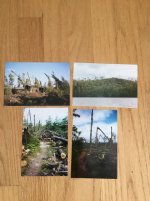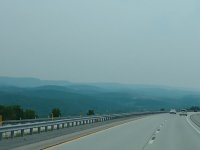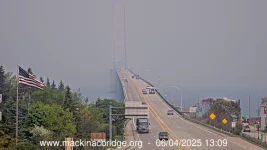Holy, smoke has been so thick in G Town for the last week, can't even see across the lake. Every summer has these periods up here, we are a tinder box at the moment. Walked a 2 kilometre port yesterday, usually has a huge loon sh1t sucking hole in the middle that swallows shoes, and it was dry as a bone, first time I've ever seen it like that.
As for the logging debate, the forestry companies are just as guilty as politicians for using science mumbo jumbo to justify what ever destructive practice they engage in. The boreal has about a hundred year life span, and fire is a natural part of that cycle. Left to it's own devices, we would have massive fires burning up here on a regular basis, but generally on an 80 to a 100 year cycle. Once a fire has burned through a large area, it should be good for a century. The forestry industry has coerced the government into providing fire suppression, which actually prolongs the problem, and in many cases, results in even larger and more frequent fires in the long run. As well, active suppression of natural re-growth changes the entire nature of the boreal, eliminating all hardwoods and browse in favour of creating a monoculture of spruce and jackpine. After fires, poplar and birch are usually the first trees to regenerate, but in clearcuts, they are quickly killed off by spraying glyphosate over huge tracts, and then replanted with conifers. Thirty years later, the same block can be harvested again, even though the trees are small, what we commonly call peckerwood. It is my opinion that these replanted monoculture blocks are more prone to burning down due to the lack of diversity. The forest companies know this, but their plan is to harvest the blocks before they burn down. However, when the forest industry crashes, usually due to external market fluctuations (tariffs), the blocks don't get harvested, and hence the risk of fire increases.
I have been on the advisory group to the forestry groups around here for about 20 years. The harvesting practices up here have always been clearcutting, where every species in a given area is cut down, but only two species are harvested, leaving great piles of waste. However, it has never been called clearcutting, as that might trigger the larger population of enviro-urbanites down south. Instead, we have had a variety of "scientific" justifications of obliterating huge tracts of trees. Two theories have been used the most, the first being that harvesting practices have to emulate forest fires, hence it is perfectly natural to denude the boreal of many miles of trees within days.
The second theory was a real stretch, called the Caribou Mosaic. The idea was that the huge areas of clear cuts had to be separated by substantial borders of untouched boreal, so that the Woodland Caribou could exist unmolested. The reality of what was going on had nothing to do with the Caribou. Tree harvesting is based on large cut plans that have a lot of scientific data in them. Large areas of the boreal are studied to determine the age and size of the trees. Up here, a tree with a diameter of around five inches is considered big enough to harvest for pulpwood. So the areas of clearcut that were codified as the Caribou Mosaic were actually areas were the trees had reached a harvestable size, and had nothing to do with preserving caribou.
So in my opinion, the science is not settled, but is instead developing as every new justification is put into place to clear cut, with the results really not being known for 50 years or so. Before fire suppression, I believe the boreal was a more stable environment, where very large fires would correct overly mature forests, and then bring about stability for the next century. With the patch work clear cutting going on up here now, the boreal lacks the reliability of the fire cycle, and fire potential is actually increased due to a variety of man made interventions, ranging from replanting practices to fire suppression.



